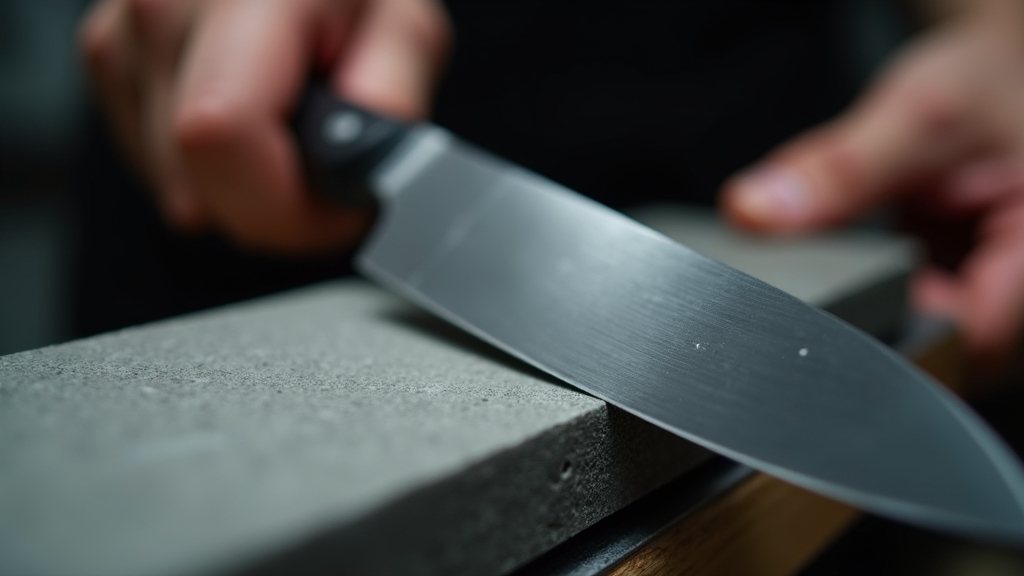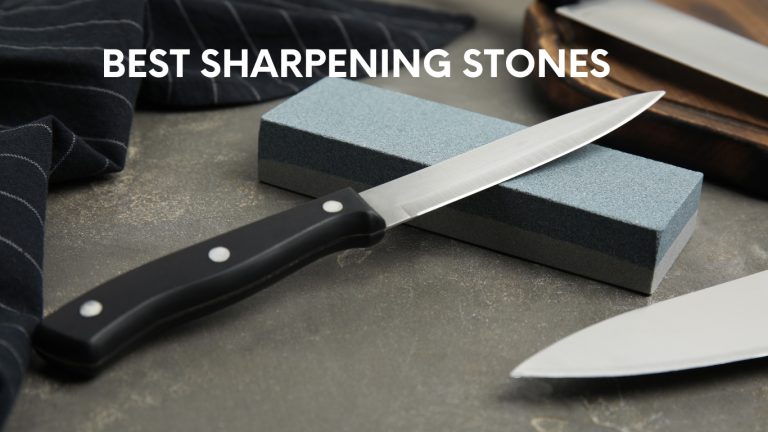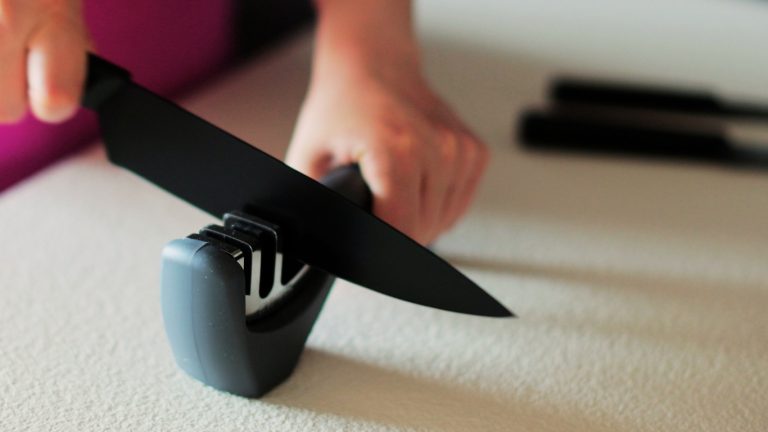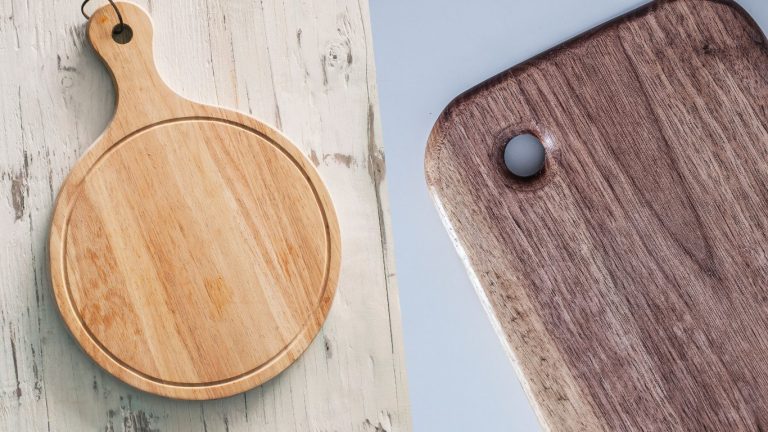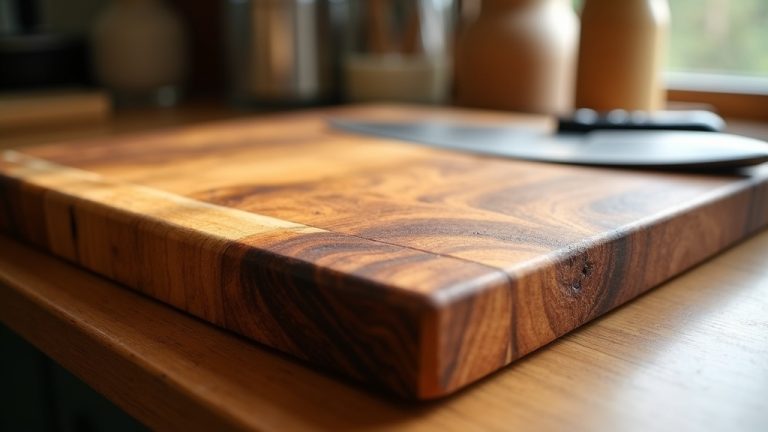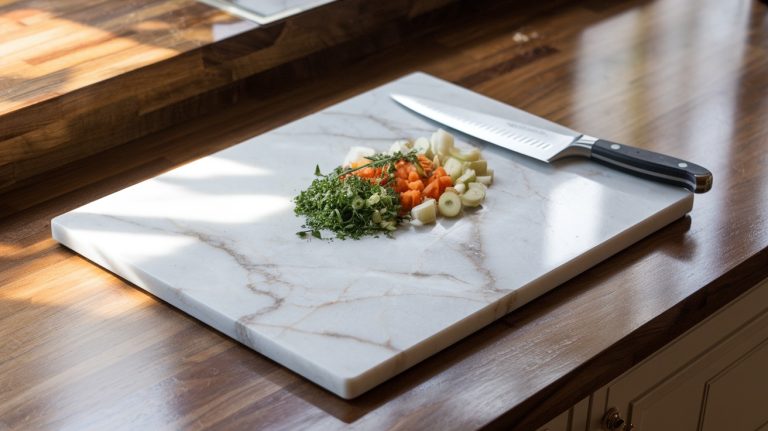Angle Guide for Knife Sharpening: Quick Pro Tips
You need an angle guide to sharpen your knife with consistent precision, which directly impacts edge sharpness and durability.
Common sharpening angles range from 10° to 20° per side, depending on your knife type.
To keep the angle steady, lock your wrist and use guides or digital tools for accuracy.
Building a custom angle guide tailored to your knives ensures repeatable results.
This approach helps you master the right angle for sharper, longer-lasting edges and ideal performance.
Key Takeaways
- Sharpening angles affect knife sharpness, durability, and edge longevity, making proper angle selection crucial.
- Common angles vary by knife type: Japanese (10-15°), Western (17-20°), Santoku (15-17°), and specialty blades (up to 35°).
- Angle guides like honing rods, fixed-height guides, and digital angle finders help maintain consistent sharpening angles.
- Custom angle guides can be built using durable materials and adjustment features for precise, repeatable edge maintenance.
- Techniques such as locking the wrist and the “Sharpie Trick” improve angle control during freehand sharpening.
Understanding the Importance of Sharpening Angles
When you sharpen a knife, the angle you choose directly affects its performance and longevity. A steeper angle enhances edge durability and impact resistance, making the blade strong enough for heavy tasks. This toughness is often due to elements like molybdenum and nickel in the steel composition, which help the blade handle impacts without chipping.
Conversely, a shallower angle produces a sharper, cleaner edge that excels in precision cutting but sacrifices some durability. Maintaining a consistent angle throughout sharpening is vital. It ensures uniform edge quality, reduces unnecessary steel removal, and strengthens the blade by minimizing stress points. Knife makers often balance hardness and toughness during heat treatment to optimize both edge retention and durability.
The angle also influences how the knife interacts with various materials, impacting cutting efficiency and edge retention. Selecting the right angle depends on your knife’s construction, intended use, and personal preference. Stainless steel knives, for example, typically perform best when sharpened between 15-20 degrees to maximize edge retention and corrosion resistance.
Common Sharpening Angles for Different Knives
Although choosing the right sharpening angle depends on your knife’s purpose and steel type, understanding common angle ranges helps you sharpen effectively.
Japanese knives typically sharpen between 10-15 degrees per side, delivering razor-sharp edges ideal for slicing.
Japanese knives sharpen at 10-15 degrees per side for precise, razor-sharp slicing edges.
Western knives require wider angles, usually 17-20 degrees per side, balancing sharpness with durability for chopping.
Santoku knives fall between 15-17 degrees per side, suitable for versatile kitchen tasks.
For specialized knives, filleting blades use 10-15 degrees for delicate cuts, while hunting knives sharpen at 22-30 degrees for toughness.
Cleavers and axes demand even wider angles, around 30-35 degrees per side, to withstand heavy impact.
Matching your sharpening angle to the knife’s design and use ensures ideal edge performance and longevity.
Keep in mind that steel composition also plays a crucial role in determining the optimal sharpening angle for your knife.
Techniques to Maintain a Consistent Sharpening Angle
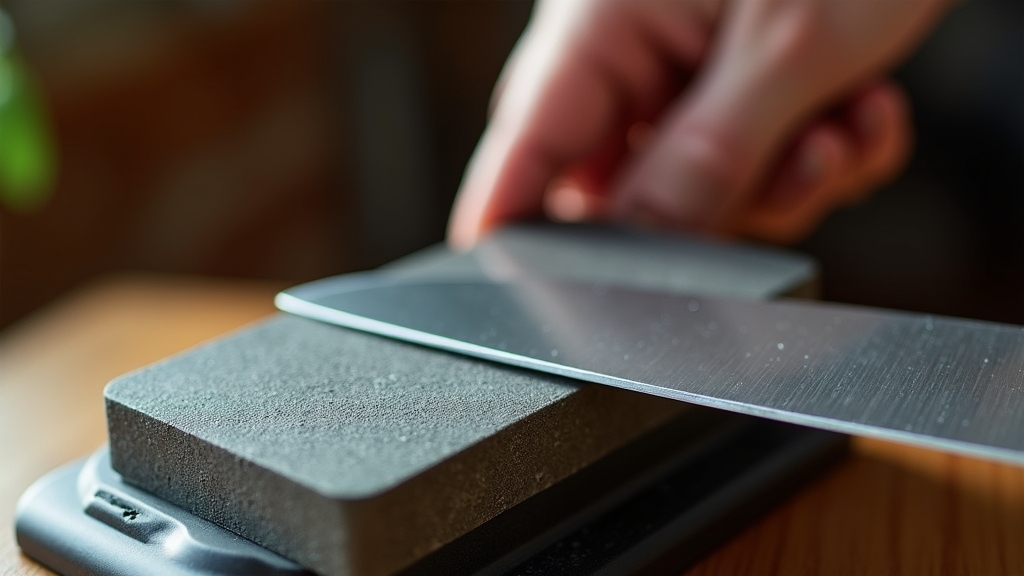
Choosing the right sharpening angle sets the foundation, but maintaining that angle consistently throughout sharpening is what guarantees a sharp, durable edge.
To achieve this, lock your wrist to minimize unintended movements and engage larger muscles in your arm and shoulder for steady control. Many sharpeners offer angle adjustment features to help maintain this consistency.
Secure your grip on the handle, keeping fingers clear to ensure consistent edge presentation.
Use techniques like the Sharpie Trick, coloring the bevel and observing marker removal to visually confirm and adjust your angle.
Apply even pressure along the blade, and segment longer blades to maintain control. Remember to keep pressure light, as light pressure allows the abrasive to do the work effectively.
Regularly check for burr formation and edge uniformity under good light to catch inconsistencies early.
Practice builds muscle memory, making consistent angle maintenance second nature, improving precision, and ensuring a lasting, razor-sharp edge.
Tools and Methods for Measuring Sharpening Angles
Because maintaining the correct sharpening angle is essential for edge performance, using the right tools and methods to measure it guarantees consistency and accuracy.
You can rely on traditional tools like digital angle finders, protractors, and inclinometers for straightforward angle verification.
Sharpening rails and honing guides help maintain set heights but offer less flexibility. Using a rail set at a fixed height, such as 4.5 mm or 6.5 mm, can simplify angle consistency but may limit customization of the sharpening angle fixed height limitation. It is also important to maintain a consistent angle of 15-20 degrees, as this range is ideal for most knives to ensure proper edge alignment.
For higher precision, digital angle cubes, laser goniometers, and electronic level sensors deliver exact measurements directly on the blade.
Multiaxis angle finders and micro-adjustment tools allow fine-tuning across complex angles.
Guided sharpening systems, including mechanical sharpeners and stationary tables, provide stable environments and preset angles.
Simple methods like tape and rulers work for rough estimation.
Selecting the right measurement method depends on your sharpening needs, balancing accuracy, convenience, and tool availability. Considering the steel composition of your knife can also influence the choice of angle and sharpening technique.
How to Build and Use a Custom Angle Guide?
Measuring sharpening angles accurately is a solid foundation, but building your own custom angle guide gives you hands-on control and repeatable precision.
Start with durable aluminum plates and wooden rails, using long bolts and rods to create an adjustable clamping system that firmly pinches your knife. The bolt mechanism must allow fine angle adjustments, ideally as precise as one degree.
Understanding the importance of angle control helps ensure that your guide consistently produces edges that balance sharpness and durability. This precision is especially critical when working with single bevel knives, which require specific angles for optimal performance.
This setup guarantees consistent edge angles, vital for maintaining blade quality. Customize the guide to your knife type, whether Japanese or European, and intended use, adjusting between 12 and 30 degrees depending on tasks like slicing or chopping.
Using your guide reinforces proper freehand sharpening technique, offering repeatability and durability.
Whether for professional kitchens or hobbyists, a custom angle guide is an invaluable tool for mastering and maintaining essential sharpening angles.
Frequently Asked Questions
Can Sharpening Angles Affect Knife Safety During Use?
Yes, sharpening angles definitely affect knife safety. When you keep your knife sharp at the correct angle, it cuts smoothly with less force, reducing slips and accidents.
If the angle is too steep or inconsistent, the blade dulls or chips faster, forcing you to apply more pressure and increasing injury risk.
How Often Should I Adjust the Sharpening Angle for Different Knives?
You should adjust sharpening angles based on knife type and wear.
For Japanese knives, tweak angles only if chips or dullness occur.
Western chef’s knives benefit from occasional slight angle increases for durability.
Outdoor and hunting knives need more frequent angle checks, especially after heavy use or chipping.
Utility and pocket knives require angle changes depending on wear and sharpening frequency.
Always adjust angles incrementally to balance sharpness and edge strength.
Do Sharpening Angles Vary for Serrated Versus Straight-Edged Knives?
Yes, sharpening angles do vary between serrated and straight-edged knives.
Serrated knives typically use a shallower bevel angle between 13° and 17°, focusing only on the beveled side with tapered rods.
Straight-edged knives require steeper angles, usually 20° to 25° per side, sharpening the entire edge uniformly.
You need to maintain these distinct angles to preserve each knife’s cutting performance and longevity effectively.
What Are Common Mistakes When Using Angle Guides for Sharpening?
You mightn’t realize that over 60% of knife edges get dulled due to angle inconsistency when sharpening.
Common mistakes include relying on generic guides that misrepresent true blade angles, failing to maintain a steady angle during sharpening, and choosing incorrect angles for your knife type.
Also, applying too much pressure or rushing leads to uneven edges.
Focus on consistent, calibrated angles and controlled strokes to preserve sharpness and edge longevity.
Can Improper Sharpening Angles Damage the Knife Blade Permanently?
Yes, sharpening your knife at improper angles can permanently damage the blade.
You risk altering the edge geometry, creating uneven bevels, and thinning or thickening the edge beyond specs.
Over time, this causes chips, rolling, and accelerated wear, making the knife difficult or impossible to restore properly.
To protect your blade, maintain consistent, correct angles during sharpening and avoid aggressive or erratic techniques that compromise edge integrity.
Test your edge: simple checks for consistent angles
Mastering the right sharpening angle boosts your knife’s performance and lifespan.
Did you know that most kitchen knives sharpen best between 15° and 20° per side?
Keeping a consistent angle is essential, and using an angle guide makes this easier than you might think.
By understanding and measuring your angles precisely, you’ll guarantee cleaner cuts and safer handling every time.
Take control of your sharpening routine, and your knives will thank you.

